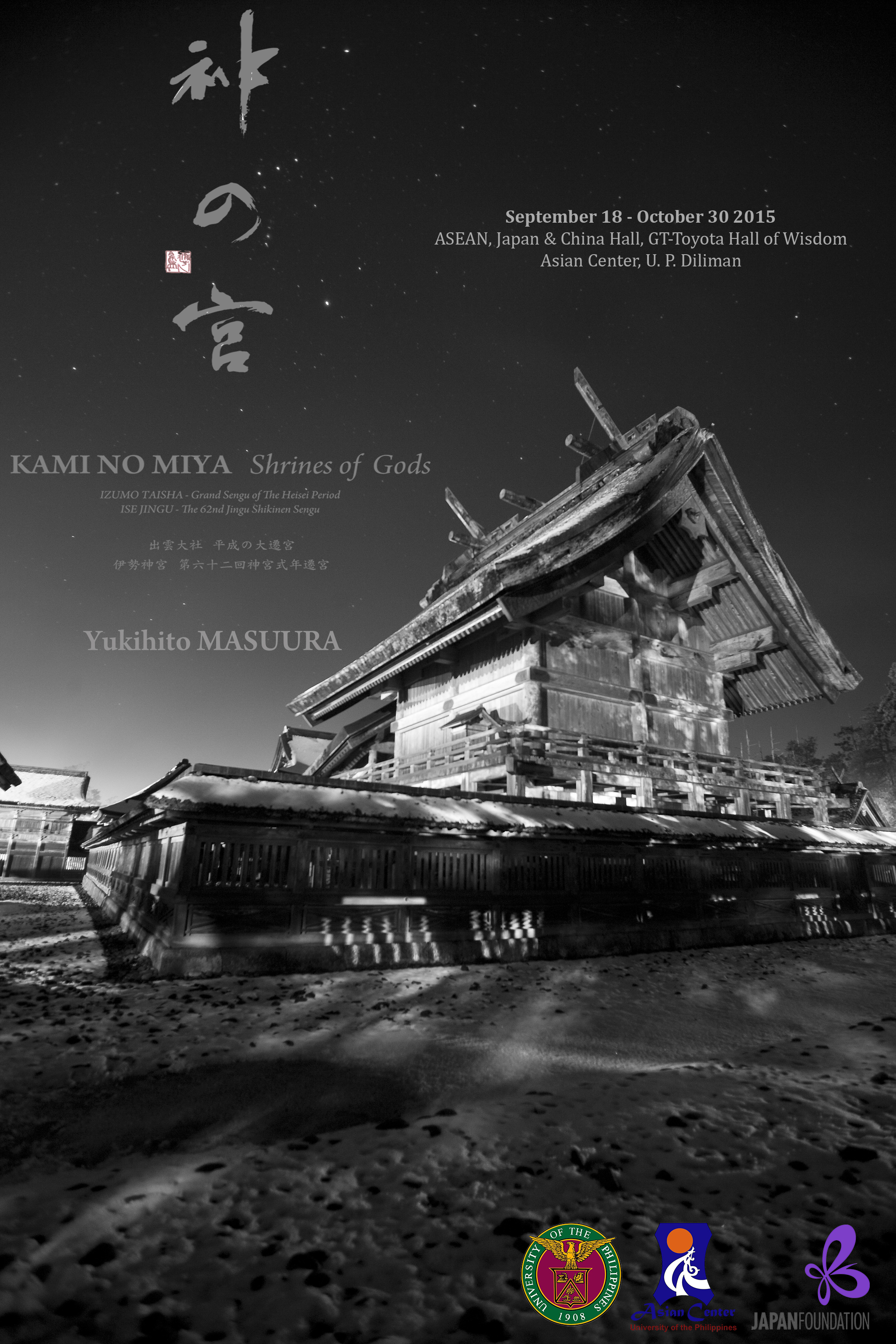 The Asian Center, University of the Philippines Diliman and the Japan Foundation will be launching a photo exhibit, “Land of Sustainability, Cradle of Divinities Ise and Izumo Kami No Miya,” by Yukihito Masuura from 18 September 2015 to 30 October 2015, at the Hall of Wisdom, GT-Toyota Asian Cultural Center, Asian Center, University of the Philippines Diliman. The exhibit is free and open to the public.
The Asian Center, University of the Philippines Diliman and the Japan Foundation will be launching a photo exhibit, “Land of Sustainability, Cradle of Divinities Ise and Izumo Kami No Miya,” by Yukihito Masuura from 18 September 2015 to 30 October 2015, at the Hall of Wisdom, GT-Toyota Asian Cultural Center, Asian Center, University of the Philippines Diliman. The exhibit is free and open to the public.
The exhibit features Masuura’s photographs of ceremonial practices in two of Japan’s most revered Shinto shrines—Ise Jingu and Izumo Taisha—in 2013. The images explore the relationship between religion and art, and skillfully capture the “divine essence” of the Senzasai rituals. Shinto is the traditional religion of Japan, and revolves on the worship of spirits in nature. Senzasai is "a festival held for a building that is to be dismantled and rebuilt, or undergo major repairs. Before construction begins, the deity must be transferred to temporary quarters and then returned when the permanent structure is completed." Learn more at Japanese Architecture and Art Net Users System."
Masuura intimates that “through photography I discovered the existence of the “Invisible World,” and that “I was lucky enough to be given the opportunity to record Sengu shrine restoration and ceremonies ‒a culture symbolising Japanese spirituality. This exhibition is to express my wishes for a peaceful world.”
Kami No Miya also introduces some of Yukihito Masuura's photographs of select sculptures of Michaelangelo, Rodin, and Bourdelle. “The art of sculpture photography is to let the sculpture speak,” shares the artist. “My photography made Bourdelle's works move and Rodin's spin. In retrospect the crying agony of the images might have been a reflection of my personal struggles around that time. I used only my camera and natural light in dark churches. When I had almost given up hope, the light played a miracle each time and produced three providential works.”
The images—37 of them—are collectively inspired by Shinto and Christianity and juxtapose the quintessential cultures of the West and Japan.
Yukihito Masuura first became enchanted by photography at the age of twelve. Born in Tokyo in 1963, he moved to France when he was eighteen, and became an assistant to Guy Bourdin for Vogue Paris. In his quest for creative and spiritual perfection, he was drawn to Buddhist sculpture and the masterworks of Western artists like Aristide Maillol (1861–1944), Antoine Bourdelle (1861–1929), Auguste Rodin (1840–1917), and Michelangelo Buonarroti (1475–1564). Visit his website.
The photographs will be housed at the ASEAN, Japan, and China Halls of the Hall of Wisdom, GT-Toyota Asian Cultural Center, Asian Center, University of the Philippines Diliman.
Here is the schedule of activities for opening day, 18 September 2015. Registration begins at 12:50 pm to be followed by ribbon cutting; festival rites to be led by Shinto priests; and a panel discussion featuring the artist, Yukihito Masuura; the Representative Director of Kami No Miya Kyodotai; and Professor Jose Alberto C. Tañedo of the UP College of Fine Arts, who is also Chairperson of the National Committee on Visual Arts of the National Commission for Culture and the Arts (NCCA). The panel will explore the significance of the photographs, focusing on how they capture Masuura’s notion of an “Invisible World.”
The exhibit opens for viewing at 4:30 p.m. For more information, please contact Louise Sanchez at 920.3535 or 981.8500 local 3580 or via email: This email address is being protected from spambots. You need JavaScript enabled to view it..
The Asian Center offers M.A. degrees in Asian Studies with four fields of specialization: Northeast Asia, Southeast Asia, South Asia, and West Asia. The Center also has an M.A. program in Philippine Studies that allows students to major in Philippine society and culture, Philippine foreign relations, or Philippine development studies. The Center offers a Ph.D. program in Philippine Studies in conjunction with the College of Arts and Letters and the College of Social Sciences and Philosophy. For an overview of these graduate programs, click here. The Asian Center also publishes Asian Studies: Journal of Critical Perspectives on Asia, the latest issue of which can be downloaded at the journal's website. For other news and upcoming events at the Asian Center, click here.

